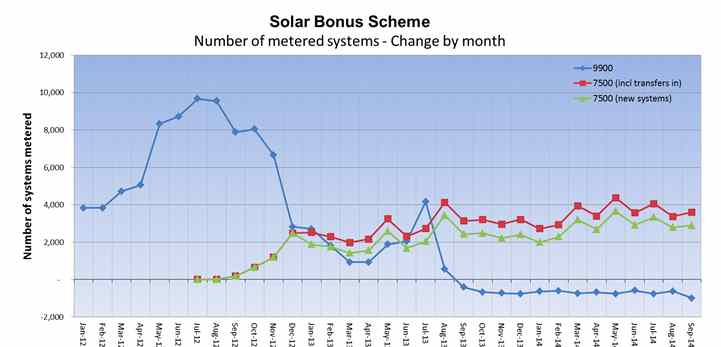The portion of rooftop solar systems that get little or no tariff in the south-east corner of Queensland has jumped to nearly one third – with 258MW of solar getting just 6c/kWh – or in some cases nothing – for their exports to the grid.
That represents just less than 30 per cent of the 883MW of rooftop solar in the region. The total amount of rooftop solar in the state is now more than 1,220MW.
New data released by Energex, which operates the network in the south-east corner and Brisbane, shows that more than 74,000 households are now on this minimal tariff. (shown in red in this graph below – please click to enlarge).
The payment for exports – if paid at all – reflects only the pricing regulator’s estimate of the “wholesale” value of the electricity plus a small credit for the lack of transmission losses. This contrasts with practice in the US, and recommendations from the solar industry here, that rooftop solar should also benefit from its network benefits, not to mention health and environmental gains.
Despite this, households in Queensland are still flocking to solar, with the uptake more of less steady in the past year, and since the 44c/kWh premium tariff ended in late 2012.
Another 2,680 systems were added in September in the Energex network, taking the total number to 270,335, and adding another 13MW to rooftop solar capacity. Over the past year, 46,000 systems totalling 158MW of rooftop solar capacity has been added. It shows now signs of slowing down, especially given concerns about the future of the renewable energy target, with 3,580 applications in the last month.
There are a further 96,000 systems and 339MW of solar in the rest of Queensland on the Ergon network, where another 17,000 households added solar in the last year.
Most are households who have installed solar in the last two years, but around 10 per cent of these are households who moved from the premium tariff. (Shown in blue). This is mostly due to people who sold their homes, although the “tariff police” from the Revenue Protection team have pinged nearly 400 households for having larger systems than approved, so have lost the premium tariff. Some new rooftop solar systems do not export to the grid at all, under new rules introduced by the Queensland networks.
The average domestic rooftop solar system is now 3.65kW. Around 56 per cent of rooftop solar energy production is consumed on site, while the remained is exported to the grid. That totalled 50,700MWh in the last month.
The Energex network now has nearly 20MW of large embedded solar (systems of 15kW or more) with 1.4MW added in the lat month.












